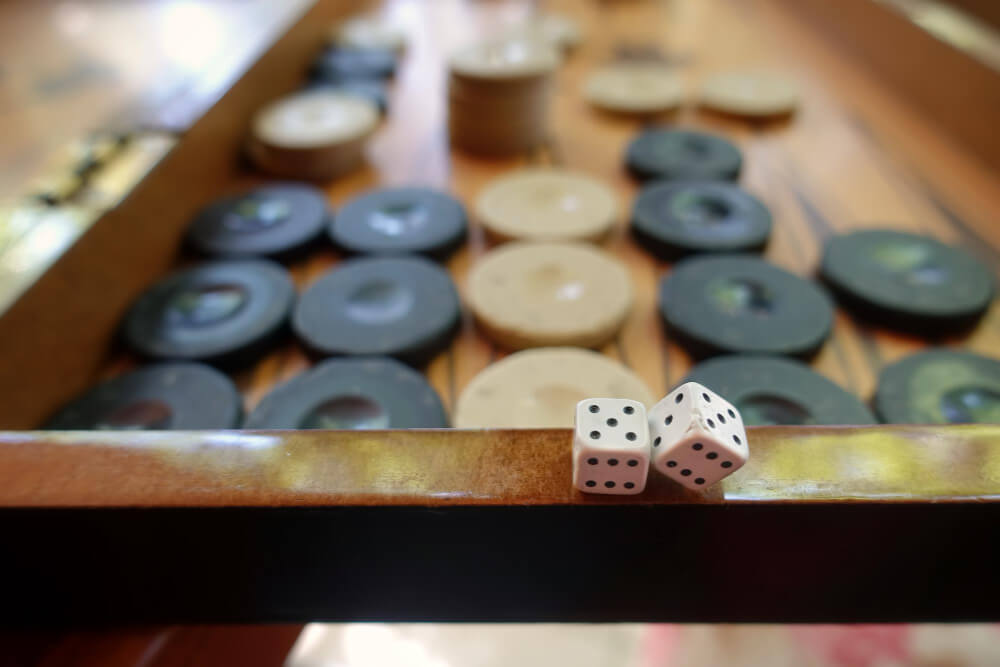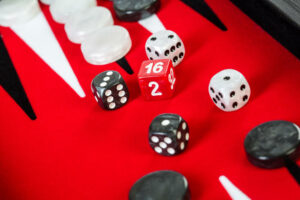When you start to learn something new, such as a game, skill, or any other subject, one of the first things you need to do is to familiarize yourself with the terminology associated with it. This will provide a common language and understanding, which is essential for every step toward becoming an expert. Backgammon is no exception, as it too has basic terms that every player should know. In this article, we will cover all the basic terms you need to know to play Backgammon.
Backgammon pieces/checkers
Pieces/Checkers are the round parts we going to move on the backgammon board. They usually look like this:
Backgammon cubes
The backgammon set includes 2 dice. Every turn starts with a roll of the dice. The Dice will determine how many steps(points) we can move with our pieces.
Home board and outer board
The backgammon board is divided into two parts. The first one is the home board. The home board is half of the board which both players need to bring the pieces into. The outer board is the second half of the board. Look at this image for a better understanding:
Bar
Between the home board and the outer board, there is a barrier that divides the board in half. This part is called “Bar”. Usually, the bar is raised surface that helps to fold the backgammon set. The bar has an important role in Backgammon. Whenever a piece gets hit, it got sent to the bar and stays there until release. Look at this image for a better understanding:
Points
Every Backgammon board consists of 24 triangles. Those triangles are called points. Our pieces can be located only on those points.
Doubles
Doubles are a unique state of the dice. Doubles are every roll that the dice show the same number. There are 6 doubles: 1-1, 2-2, 3-3, 4-4, 5-5, 6-6. Whenever a double is rolled, the player can move 4 times the number. For example, if you rolled 2-2 you can move 2,2,2,2.
Doubling cube
You can often see another kind of cube when playing Backgammon. A lot of people call it the 64 die, but in fact, this is the doubling cube. You don’t have to use this cube but professionals and tournaments are always using it. The concept of the cube is to raise the stake of the game.
The doubling cube is usually a large die with numbers 2, 4, 8, 16, 32, and 64 on its faces. To start off the game, the doubling cube is placed in between you and your opponent in the middle of the board with the number 64 facing up. This indicates that there has been no doubling yet during this game.
When either player feels they have an advantage or they want to raise the stakes of the game, they can offer a double. This is done by turning the doubling cube toward them so that their opponent now sees the number 2 face up.
The player who offered this double must then wait for their opponent to either accept or reject it. If accepted, then the number on the cube will be doubled each time a double is offered and accepted during that same game – at this moment winning the game will equal more points (by how much the cube is showing).
In addition, if your opponent accepted the doubling offer, he controls the doubling cube and only he can offer another doubling.
If your opponent rejects your double, the game is over and you get the points the cube is showing (before the doubling offer)
Secure a point
This term is referring to control of a point. When you have 2 or more pieces on a point you control the point and the opponent can’t land on it till the moment you no longer control it. Secure points are an important factor in Backgammon.
Blot
Blot is a piece that sits alone on a point. Blots are vulnerable to the opponent’s piece landing on them (also called a hit) and sending them to the bar. Once blot got hit the first obligation is to re-enter them back to the game.
Hitting
Hit is an attacking move on the opponent. In order to hit you need to land with one of your pieces on the opponent’s blot. Hitting will send the piece to the bar. Hitting is an important part Of Backgammon.
Primming
Prime is a few consecutive secured points. A prime can make a hard time for your opponent to move through. A 6 prime is 6 consecutive secured points – which means your opponent can go through at all – ideal situation. Good Backgammon players always think about priming.
Splitting
Splitting is taking a secured point with 2 pieces and dividing it into 2 blots. This is a risky move and usually happening with the runners ( The pieces that start the game at the opponent’s home)
Slotting
Slotting is separating one piece from a secured point in order to secure another point in the next turns. Slotting is a risky move because for a few turns you have a blot. Although is a risky move, when done right with a risk calculation, slotting can be very beneficial. If you want to upgrade your risk calculation ability, check this article about Backgammon dice probability.
Builder
Builder is a piece moved from the outer board into the home board with the intention to secure a point in the following turns. The following image will clarify:
Anchor
Anchor is a point that you managed to secure at your opponent’s home. This can be an important point because you will always have a sage point to re-enter. The 5-point is the best anchor point.
Bear-off
The goal of the game is to bring all your pieces into your home and then remove them off the board. The term for removing the pieces from the board is called bearing off.
Gammon
When you succeed in bearing off all your pieces before your opponent starts to bear off (0 pieces removed). This kind of win gets the winner 2 points. The backgammon board would look something like this:
You can see the black pieces are all removed while there are still 15 white pieces on the board.
Backgammon
When you succeed in Bearing off all your pieces while there are still opponent pieces in your home base or on the bar. This kind of win gets the winner 3 points. The backgammon board would look something like this:
You can see there is a white piece at the black home base.
Now that you know the basics of backgammon, it’s time to put your knowledge into practice. With a little bit of study and practice, you’ll be playing like a pro in no time! So grab some friends or family members and get ready for an exciting game of strategy and skill. Good luck and happy gaming!






